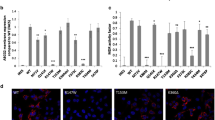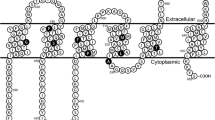Abstract
Clinical studies have strongly suggested that genetic polymorphisms and/or mutations of certain ATP-binding cassette (ABC) transporter genes might be regarded as significant factors affecting patients’ responses to medication and/or the risk of diseases. In the case of ABCG2, certain single nucleotide polymorphisms (SNPs) in the encoding gene alter the substrate specificity and/or enhance endoplasmic reticulum-associated degradation (ERAD) of the de novo synthesized ABCG2 protein via the ubiquitin-mediated proteasomal proteolysis pathway. Hitherto accumulated clinical data imply that several nonsynonymous SNPs affect the ABCG2-mediated clearance of drugs or cellular metabolites, although some controversies still exist. Therefore, we recently developed high-speed functional screening and ERAD of ABC transporters so as to evaluate the effect of genetic polymorphisms on their function and protein expression levels in vitro. In this chapter we present in vitro experimental methods to elucidate the impact of nonsynonymous SNPs on protein degradation of ABCG2 as well as on its transport function.
Access this chapter
Tax calculation will be finalised at checkout
Purchases are for personal use only
Similar content being viewed by others
References
Evans WE, Johnson JA (2001) Pharmacogenomics: the inherited basis for interindividual differences in drug response. Annu Rev Genomics Hum Genet 2:9–39
Evans WE, Relling MV (1999) Pharmacoge-nomics: translating functional genomics into rational therapeutics. Science 286:487–491
Kroetz DL, Yee SW, Giacomini GK (2010) The pharmacogenomics of membrane transporters project: research at the interface of genomics and transporter pharmacology. Clin Pharmacol Ther 87:109–116
Kim RB (2002) Pharmacogenetics of CYP enzymes and drug transporters: remarkable recent advances. Adv Drug Deliv Rev 54:1241–1242
Ishikawa T, Tsuji A, Inui K et al (2004) The genetic polymorphism of drug transporters: functional analysis approaches. Pharmacogenomics 5:67–99
Nakagawa H, Toyoda Y, Wakabayashi-Nakao K et al (2011) Ubiquitin-mediated proteasomal degradation of ABC transporters: a new aspect of genetic polymorphisms and clinical impacts. J Pharm Sci 100:3602–3619
Ellgaard L, Molinari M, Helenius A (1999) Setting the standards: quality control in the secretory pathway. Science 286:1882–1888
Mori K (2000) Tripartite management of unfolded proteins in the endoplasmic reticulum. Cell 101:451–454
Hampton RY (2002) ER-associated degradation in protein quality control and cellular regulation. Curr Opin Cell Biol 14:476–482
Kleizen B, Braakman I (2004) Protein folding and quality control in the endoplasmic reticulum. Curr Opin Cell Biol 16:343–349
Sauer B (1994) Site-specific recombination: developments and applications. Curr Opin Biotechnol 5:521–527
Gronostajski RM, Sadowski PD (1985) Determination of DNA sequences essential for FLP-mediated recombination by a novel method. J Biol Chem 260:12320–12327
Jayaram M (1985) Two-micrometer circle site-specific recombination: the minimal substrate and the possible role of flanking sequences. Proc Natl Acad Sci USA 82:5875–5879
Senecoff JF, Bruckner RC, Cox MM (1985) The FLP recombinase of the yeast 2-micron plasmid: characterization of its recombination site. Proc Natl Acad Sci USA 82:7270–7274
Andrews BJ, Proteau GA, Beatty LG et al (1985) The FLP recombinase of the 2 micron circle DNA of yeast: interaction with its target sequences. Cell 40:795–803
Boshart M, Weber F, Jahn G et al (1985) A very strong enhancer is located upstream of an immediate early gene of human cytomegalovirus. Cell 41:521–530
Nelson JA, Reynolds-Kohler C, Smith BA (1987) Negative and positive regulation by a short segment in the 5'-flanking region of the human cytomegalovirus major immediate-early gene. Mol Cell Biol 7:4125–4129
Andersson S, Davis DL, Dahlback H et al (1989) Cloning, structure, and expression of the mitochondrial cytochrome P-450 sterol 26-hydroxylase, a bile acid biosynthetic enzyme. J Biol Chem 264:8222–8229
Gritz L, Davies J (1983) Plasmid-encoded hygromycin B resistance: the sequence of hygromycin B phosphotransferase gene and its expression in Escherichia coli and Saccharomyces cerevisiae. Gene 25:179–188
Broach JR, Hicks JB (1980) Replication and recombination functions associated with the yeast plasmid, 2 mu circle. Cell 21:501–508
Broach JR, Guarascio VR, Jayaram M (1982) Recombination within the yeast plasmid 2 mu circle is site-specific. Cell 29:227–234
Argos P, Landy A, Abremski K et al (1986) The integrase family of site-specific recombinases: regional similarities and global diversity. EMBO J 5:433–440
Craig NL (1988) The mechanism of conservative site-specific recombination. Annu Rev Genet 22:77–105
Buchholz F, Ringrose L, Angrand PO et al (1996) Different thermostabilities of FLP and Cre recombinases: implications for applied site-specific recombination. Nucleic Acids Res 24:4256–4262
Mitomo H, Kato R, Ito A et al (2003) A functional study on polymorphism of the ATP-binding cassette transporter ABCG2: critical role of arginine-482 in methotrexate transport. Biochem J 373:767–774
Tamura A, Wakabayashi K, Onishi Y et al (2006) Genetic polymorphisms of human ABC transporter ABCG2: development of the standard method for functional validation of SNPs by using the Flp recombinase system. J Exp Ther Oncol 6:1–11
Wakabayashi-Nakao K, Tamura A, Koshiba S et al (2010) Production of cells with targeted integration of gene variants of human ABC transporter for stable and regulated expression using the Flp recombinase system. Methods Mol Biol 648:139–159
Tamura A, Wakabayashi K, Onishi Y et al (2007) Re-evaluation and functional classification of non-synonymous single nucleotide polymorphisms of the human ATP-binding cassette transporter ABCG2. Cancer Sci 98:231–239
Ishikawa T, Sakurai A, Kanamori Y et al (2005) High-speed screening of human ATP-binding cassette transporter function and genetic polymorphisms: new strategies in pharmacogenomics. Methods Enzymol 400:485–510
Tamura A, Watanabe M, Saito H et al (2006) Functional validation of the genetic polymorphisms of human ATP-binding cassette (ABC) transporter ABCG2: identification of alleles that are defective in porphyrin transport. Mol Pharmacol 70:287–296
Ishikawa T, Tamura A, Saito H et al (2005) Pharmacogenomics of the human ABC transporter ABCG2: from functional evaluation to drug molecular design. Naturwissenschaften 92:451–463
Nakagawa H, Tamura A, Wakabayashi K et al (2008) Ubiquitin-mediated proteasomal degradation of non-synonymous SNP variants of human ABC transporter ABCG2. Biochem J 411:623–631
Wang P, Hammer DA, Granados RR (1997) Binding and fusion of Autographa californica nucleopolyhedrovirus to cultured insect cells. J Gen Virol 78:3081–3089
Blissard GW, Wenz JR (1992) Baculovirus gp64 envelope glycoprotein is sufficient to mediate pH-dependent membrane fusion. J Virol 66:6829–6835
Lanir LM, Volkman LE (1998) Actin binding and nucleation by Autographa californica M nucleopolyhedrovirus. Virology 243:167–177
Whittaker GR, Helenius A (1998) Nuclear import and export of viruses and virus genomes. Virology 246:1–23
An R, Hagiya Y, Tamura A et al (2009) Cellular phototoxicity evoked through the inhibition of human ABC transporter ABCG2 by cyclin-dependent kinase inhibitors in vitro. Pharm Res 26:449–458
Saito H, Hirano H, Nakagawa H et al (2006) A new strategy of high-speed screening and quantitative structure-activity relationship analysis to evaluate human ATP-binding cassette transporter ABCG2-drug interactions. J Pharmacol Exp Ther 317:1114–1124
Saito H, Hirano H, Shin W et al (2009) Technical pitfalls and improvements in high-speed screening and QSAR analysis to predict durg–drug interactions of ABC transporter ABCB11 (bile salt export pump). AAPS J 11:581–589
Elbein AD, Pan YT, Pastuszak I et al (2003) New insights on trehalose: a multifunctional molecule. Glycobiology 13:17R–27R
Furuki T, Oku K, Sakurai M (2009) Thermodynamic, hydration and structural characterization of alpha, alpha-trehalose. Front Biosci 14:3523–3535
Guo N, Puhlev I, Brown DR et al (2008) Trehalose expression confers desiccation tolerance on human cells. Nat Biotechnol 18:168–171
Deghan A, Köttgen A, Yang Q et al (2008) Association of three genetic loci with uric acid concentration and risk of gout: a genome-wide association study. Lancet 372:1953–1961
Kolz M, Johnson T, Sanna S et al (2009) Meta-analysis of 28,141 individuals identifies common variants within five new loci that influence uric acid concentrations. PLoS Genet 5:e1000504
Stark K, Reinhard W, Grassi M et al (2009) Common polymorphisms influencing serum uric acid levels contribute to susceptibility to gout, but not to coronary artery disease. PLoS One 4:e7729
Woodward O, Köttgen A, Coresh J et al (2009) Identification of a urate transporter, ABCG2, with a common functional polymorphism causing gout. Proc Natl Acad Sci USA 106:10338–10342
Matsuo H, Takada T, Ichida K et al (2009) Common defects of ABCG2, a high-capacity urate exporter, cause gout. A function-based genetic analysis in a Japanese population. Sci Transl Med 1:5ra11
Acknowledgments
The study performed in the authors’ laboratory was supported by the NEDO International Joint Research Grant program “International standardization of functional analysis technology for genetic polymorphisms of drug transporters” as well as a Grant-in-Aid for Scientific Research (A) (No. 18201041) and Grants for Exploratory Research (No. 19659136 and No. 23650619) from the Japanese Society for the Promotion of Science (JSPS).
Author information
Authors and Affiliations
Editor information
Editors and Affiliations
Rights and permissions
Copyright information
© 2013 Springer Science+Business Media, LLC
About this protocol
Cite this protocol
Ishikawa, T., Wakabayashi-Nakao, K., Nakagawa, H. (2013). Methods to Examine the Impact of Nonsynonymous SNPs on Protein Degradation and Function of Human ABC Transporter. In: Innocenti, F., van Schaik, R. (eds) Pharmacogenomics. Methods in Molecular Biology, vol 1015. Humana Press, Totowa, NJ. https://doi.org/10.1007/978-1-62703-435-7_15
Download citation
DOI: https://doi.org/10.1007/978-1-62703-435-7_15
Published:
Publisher Name: Humana Press, Totowa, NJ
Print ISBN: 978-1-62703-434-0
Online ISBN: 978-1-62703-435-7
eBook Packages: Springer Protocols




